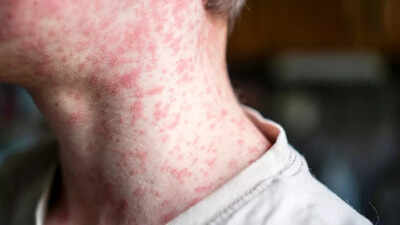- News
- lifestyle
- health-fitness
- health-news
- Measles cases on the rise among youngsters in Kansas: How to prevent the disease
Trending
Measles cases on the rise among youngsters in Kansas: How to prevent the disease
Six measles cases have been confirmed in Grant and Stevens counties this year in unvaccinated individuals under 18. Adrienne Byrne, Sedgwick County Health Director, highlights proactive measures, including a free vaccination clinic on March 22. Rising cases underscore the importance of vaccination, with the CDC confirming 301 cases nationally. WHO emphasizes community-wide vaccination for effective prevention.
A total of six cases have been confirmed this year in southwest Kansas, particularly in Grant and Stevens counties. This follows the initial report of a single case in Stevens County on March 14, 2025, which was the first case in Kansas since 2018. The additional five cases were identified within a week, which hints at a growing outbreak in the region. All six cases involve unvaccinated people, under the age of 18, according to the Kansas Department of Health and Environment (KDHE).
“There were no reported cases in Sedgwick County, but we are taking proactive steps to prevent the spread,” Adrienne Byrne, Sedgwick County Health Director said. “We’ve seen cases in 2014 and 2017, so this isn’t our first time dealing with measles.”
Byrnes also stated that there is a slight increase in people not wanting to take vaccination, due to personal reasons, including religious and philosophical beliefs.

The Sedgwick County Health Department is hosting a free vaccination clinic on Saturday, March 22. The clinic will be held at the West Central Clinic, located at 2716 West Central, from 10 a.m. to 3 p.m. The MMR vaccine will be available for adults and children 12 months and older. Though appointments are encouraged, it is not mandatory. People can walk in until 2 p.m. on Saturday.

The number of measles cases is on the rise in the US, with the CDC confirming 301 cases as of Mar. 13, and one death, while one is under investigation. The health agency also confirmed that 95% of the cases are found in unvaccinated (and vaccination status unknown) individuals. As the cases are on the rise, health officials are urging residents to get vaccinated.

Measles is a highly contagious respiratory disease spread through the air by coughing, sneezing, or breathing, and it can remain infectious in the air or on surfaces for up to two hours after an infected person leaves the area. Symptoms typically appear 10 to 14 days after exposure and include a fever over 101°F, cough, runny nose, and red and watery eyes, followed by a red rash that starts on the face and spreads to the rest of the body.
How to prevent it?
The World Health Organization (WHO) notes that community-wide vaccination is the ‘most effective way’ to prevent measles. It advises that all children should be vaccinated against measles. “The vaccine is safe, effective, and inexpensive,” the health agency assures.
The measles vaccine is either given alone or often combined with vaccines for mumps, rubella, and/or varicella.

About the Author
TOI Lifestyle DeskEnd of Article
FOLLOW US ON SOCIAL MEDIA
Visual Stories
Tired of too many ads?










